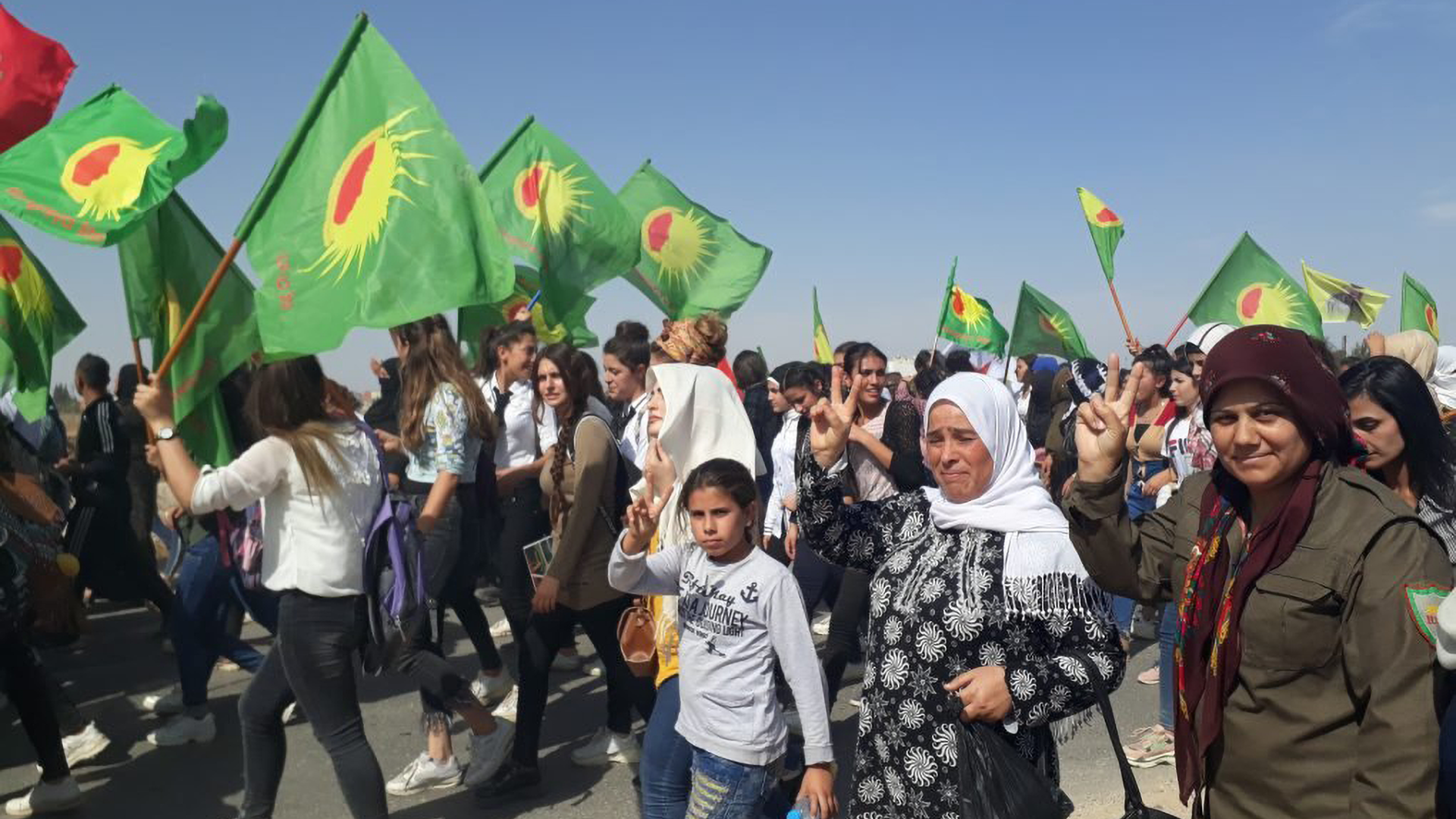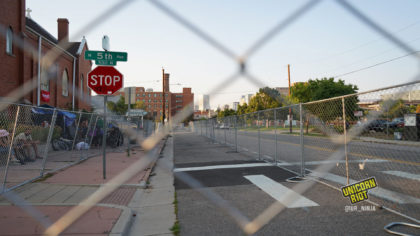Origins of the PKK and the ‘Rojava’ Revolution: Part Two
An autonomous region in northern Syria where governance is based on cooperative economics, radical ecology and women’s rights has been crafted over the last decade. This region was initially called “Rojava” (Western Kurdistan) and is now officially known as the Autonomous Administration of North and East Syria (AANES) or NES for short. This historical feat of rearranging societal norms and carving a new path for humanity has come after centuries of the Kurdish fight for independence and self-determination.
As covered previously in “Origins of the PKK and the ‘Rojava Revolution Part One,” revolutionaries in the Kurdistan Workers Party (PKK) have been engaged in a 42 year-old war with the Turkish government. This conflict has primarily taken place in the mountainous regions of southeastern Turkey but in recent years has also spilled over into northern Syria.
Since the start of the Syrian revolution of 2011 and the ongoing civil war, the PKK’s affiliate organization in Syria, the Democratic Union Party (Kurdish: Partiya Yekîtiya Demokrat, PYD) has made tremendous territorial and political gains. These gains allowed Rojava’s ‘cantons’ to declare autonomy back in January of 2014.
The Kurdish-led NES has since aimed to transform life in northern Syria, emphasizing the protection of women’s/ethnic minority rights, the environment, and an enhancement of democratic participation from the ground-up. This relatively new revolutionary program is known as ‘Democratic Confederalism,’ which stands in stark contrast to the values and vision of the self-proclaimed ‘Islamic State’, otherwise known as ISIL.
As the armed wing of the NES, the Syrian Democratic Forces (SDF) have largely defeated ISIL, yet the NES continues to be surrounded by a host of enemies – most notably an increasingly hostile Turkish state to the north. To date, the Turkish military has launched three separate military invasions, all with the stated goals of removing the SDF’s presence from the border while seizing its territory to form a ‘buffer zone’ in Syria between Turkey and the NES. These invasions have resulted in the deaths of thousands, the displacement of at least 300,000 ethnic minority people, as well as the destruction of critical infrastructure in northern Syria.
“Our intention is to establish a peace corridor with a depth of 30 kilometers and a length of 480 kilometers in Syria so that the international community can settle two million Syrians here.”
Turkish President, Recep Tayyip Erdoğan
The Turkish state has since initiated a massive Syrian refugee resettlement project which aims to repopulate this captured territory with some of the estimated 3.6 million Syrian refugees currently living in Turkey. This intentional demographic shift has been fiercely criticized and described by many as a continuation of Turkish ‘genocide‘ against ethnic minorities in the region.
The Turkish government’s hostility is due to the NES’s conception and development being directly tied to the PKK, whom the Turkish government brands as terrorists. While the U.S. also regards the PKK as a terrorist organization (even issuing a combined $12 million bounty for capture of its leadership in 2018), unlike the Turkish government, it makes a legal distinction between the PKK in Turkey and their PYD comrades in Syria. This is because the SDF was the only military force the U.S. could depend on to defeat ISIL in northern Syria.
The Turkish government has continuously lodged protests in Washington against American “support of PKK terrorists.” These complaints mostly fell on deaf ears until 2016 when it became clear that the U.S.-SDF alliance had largely succeeded in defeating ISIL forces in the region. As a result, the U.S. began steadily withdrawing support for the NES, allowing the Turkish state the long-awaited opportunity to begin a series of military invasions between 2016-2019 against the NES. These invasions were code named Operation ‘Euphrates Shield’, Operation ‘Olive Branch’ and Operation ‘Peace Spring’.
Operation ‘Euphrates Shield’
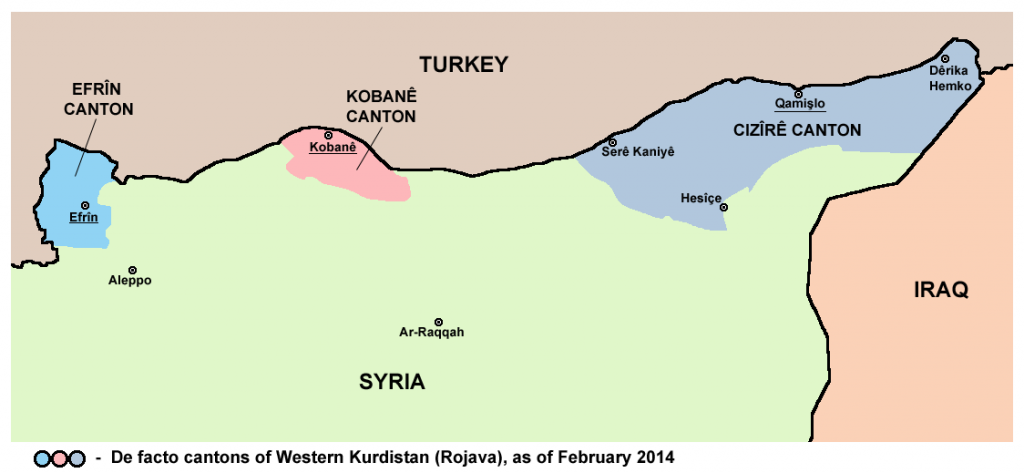
Back in January 2014 when Rojava’s ‘Cantons’ in Afrin (Kurdish: Efrînê), Kobani and Jazira (Kurdish: Cizîrê), declared autonomy, they were three geographically separate areas. This changed rapidly after a series of military offensives by the SDF, against ISIL in 2015 linked the Kobani Canton with Jazira. That following year in 2016, Kobani and Jazira were on the verge of linking up Afrin, as the SDF continued to push ISIL out of northern Syria.
These rapid advances alarmed the Turkish government, which warned SDF forces not to cross eastward across the Euphrates River. The SDF ignored these warnings and captured the city of Manbij on August 12, 2016, while continuing to push westwards towards Afrin. This led the Turkish military to make good on its threat by launching Operation Euphrates Shield on August 24, 2016.
At the time Operation Euphrates Shield represented the biggest Turkish military incursion into Syrian territory. While thousands of Turkish troops committed to the battle, the bulk of its ground troops actually consisted of smaller proxy militias affiliated with the Free Syrian Army (FSA), also known as the Turkish Free Syrian Army (TFSA).
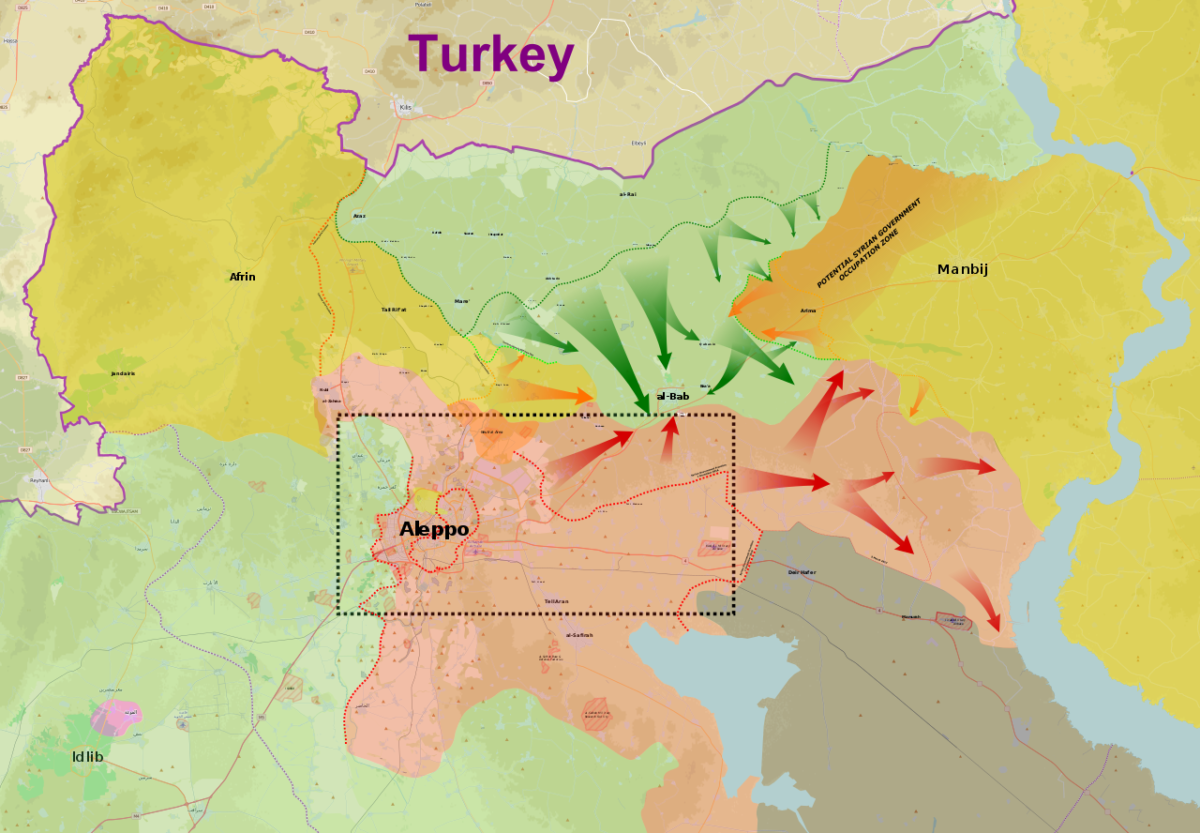
During this operation, Turkish-led forces appeared to focus on ISIL targets but quickly moved against SDF forces as well. Though the experienced and well-armed soldiers of the SDF offered stiff resistance, they were unable to stop the Turkish military due to their smaller numbers and lack of air support among other military disadvantages.
The operation succeeded in preventing the linkup of Afrin with the Kobani and Cizire cantons, though it would fail to push the SDF out of the strategically important city of Manbij. This was due to U.S. intervention as it made assurances to the Turkish government that the SDF had agreed to withdraw its Kurdish military units (YPG/YPJ) back to the eastern side of Euphrates River. In exchange, the SDF was allowed to retain control of Manbij through its non-Kurdish predominantly Arab militia units.
Operation Euphrates Shield was declared “successfully completed” by the Turkish military on March 2017. The Turkish government would proceed to bring in an estimated 50,000 displaced, mostly Arab Syrian refugees from Turkey into the areas they recently captured, and officially handed control of the area to the TFSA. This would be become standard procedure for all territory captured by the Turkish state in successive military campaigns.
Operation Olive Branch
Having isolated Afrin from the rest of the NES, the Turkish military followed up with the even more invasive Operation Olive Branch which specifically targeted the Afrin canton on January 20, 2018. The name for this operation is an intentionally cruel and ironic reference to Afrin’s global reputation for being a leading producer of olives. “Offering of an olive branch” in war also refers to the act of offering a peaceful negotiation to one’s enemy. Far from peaceful negotiation, the operation represented an unprecedented escalation by the Turkish government in its international war against Kurdish revolutionaries.
The TFSA once again made up the bulk of the invasion force, while thousands of Turkish Army personnel also participated as support units, including elements of their naval special forces and air force.

Though the SDF was again outnumbered and outgunned, tens of thousands of members rallied to its defense as resources were redirected from the fight against ISIL. Smaller numbers of volunteer fighters from the ‘International Freedom Battalion‘ (IFB) we’re also deployed to help assist the SDF in defending Afrin.
During this operation, Turkish forces and their proxy militia in the TFSA were accused of, and documented, committing multiple human rights abuses including the indiscriminate shooting of civilians trying to flee the violence at the border. Hundreds of civilians were also reportedly killed as a result of Turkish artillery and air bombing. Graphic video also emerged of alleged TFSA forces mutilating the corpse of a female SDF fighter later identified as ‘Barin Kobane’.
As the U.S. military steadily reduced its presence in northern Syria, the NES began looking to its old nemesis in the Syrian government to help resist the Turkish invasion. This led to a military agreement between the NES and Syrian government, in which the latter would agree to send its troops to assist SDF forces on the frontline. While this tactical alliance failed to stop the Turkish occupation of Afrin, it still managed to preserve at least a small sliver of land in the southernmost portion of the region, which is currently all that remains of the NES’s former Afrin territory.
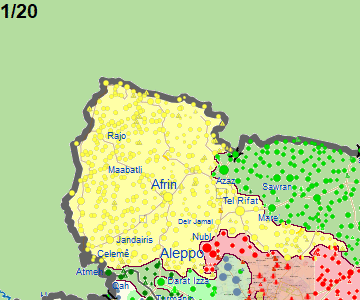
By March 19th 2018, Afrin’s capital city was in Turkish hands and the SDF had lost the majority of the Canton, yet it continues to operate in the southernmost portion and has vowed to reclaim all of this lost territory. As such, some groups affiliated with the SDF have launched an ongoing, low-level insurgency employing hit-and-run guerilla attacks against Turkish/TFSA targets in Afrin.
Operation Peace Spring
Emboldened by the large-scale defeat of the SDF in Afrin, the Turkish military would follow up with yet another invasion code-named Operation Peace Spring which began on October 9, 2019. The invasion was given the virtual green light by the Americans only a couple days beforehand, when former U.S. President Donald Trump ordered all U.S forces to retreat from the Turkish-Syrian border.
Shortly after, Turkish warplanes and artillery began a massive coordinated bombardment of NES towns such as, Tell Abyad, Kobani and Qamishli.
In 2019 Unicorn Riot spoke with ‘CJ’, a Syrian anarchist and medic who served with the SDF and witnessed the destruction in Qamishli. Like many in the NES, ‘CJ’ described the U.S pullout from the border as a blatant betrayal while also claiming that the U.S was actively helping Turkey against the SDF during the operation.
“After they [the United States military] pulled out, they actually gave a lot of intel to the Turkish fascist regime about the SDF. I cannot describe the horror that happened and the destruction that happened. A lot of people were killed.“
Quote from “CJ” a Syrian anarchist currently living in the NES
As in ‘Olive Branch’, numerous human rights violations and war crimes were again reported to be committed by Turkish forces during ‘Peace Spring’. Videos of what appears to be the extrajudicial field execution of unarmed and bound prisoners was widely circulated. One of these videos features English subtitles and an unknown gunman quoted saying “They’re prisoners, shoot them” and “Hold my phone, film me, film me while I shoot them with the sniper rifle,” as he and others fire repeatedly at the bound prisoner. (Content advisory: graphic violence. Video link)
Other graphic videos posted on social media show the lifeless body of Hervin Khalaf, a Kurdish politician and human rights activist. Photos and videos also show what appears to be her car riddled with bullet holes alongside a roadway. Some reports claim Khalaf was killed in the gunfire, while others claim she was raped and then stoned to death by Turkish-backed forces. The exact details of her death remain unclear.
On October 14, 2019, the SDF again reached a military pact with the Syrian government. In exchange for Syrian military assistance in the form of 10,000 regular Syrian Arab Army (SAA) troops, SDF forces agreed to pullout from large areas of northern Syria, such as Kobani and Manbij, and allowed the Syrian army and Russians to take their place.
Three days later, the U.S. announced it had secured a 120-hour ceasefire which gave the SDF time to negotiate with the Russians and Syrians, who in turn entered into negotiations with Turkish government on their behalf. This would lead to a Russian–Turkish agreement whereby the Turkish buffer zone extending some 32km (19 miles) into northern Syria would be recognized. All Kurdish military forces would be required to withdraw from the border while joint Russian–Turkish patrols would “start to the west and east of the buffer zone to a depth of 10 kilometers from the border”.
Current Status of the NES
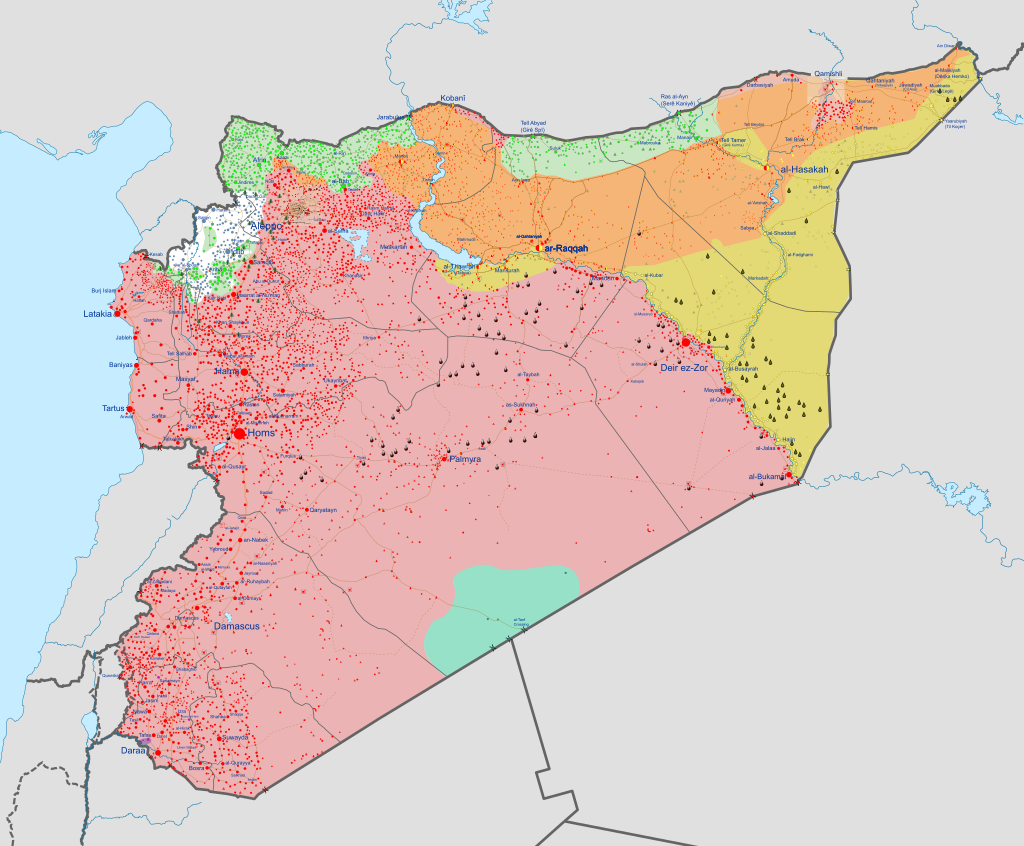
Although no new Turkish military operations in northern Syria have been launched since the end of Operation Peace Spring, the atmosphere remains tense. Despite the presence of Russian ‘peacekeepers’, small-scale skirmishes between the SDF and Turkish-backed forces continue. The U.S., Russian and Turkish military escalation in northern Syria has also added an extra layer of danger and international complexity to an already volatile war.
Russian soldiers now find themselves confronting their American and Turkish rivals on Syrian territory which has led to several accidents and close-calls, such as when a Russian Army convoy forced an American convoy to turn around as it traveled westward along the M-4 highway.
Despite Washington’s sour relationships with practically every nation/faction involved in the Syrian civil war, the U.S. military continues to operate in northern Syria, with reports surfacing that as late as February 2021 they had started construction on another military base on NES territory. Reports have also emerged that a little-known U.S. company known as Delta Crescent Energy signed a deal with the NES to extract oil from its oil fields.
Current U.S. President Joseph Biden has since attempted to re-focus efforts away from oil and back to the original stated mission of countering ISIL forces. It appears however that the U.S. is more concerned with countering the de facto Russia-Syria-Iran alliance since the majority of its documented military operations have actually been focused on targeting Iranian-backed militias along the Syrian/Iraqi border. While it is currently unknown exactly how many American troops remain in Syria, unofficial estimates range from anywhere between 900 to 3000 military personnel.
The continued presence of American forces on NES territory has raised serious debates and concerns within the larger Kurdish liberation movement. In particular, the PKK leadership has reportedly become frustrated by the Americans’ involvement and wants to sever ties, while the PYD reportedly still believes it can salvage relations with Americans.
“We are disappointed and frustrated by the current crisis. Our people are under attack, and their safety is our paramount concern. Two questions remain: How can we best protect our people? And is the United States still our ally?”
Gen. Mazloum Kobani Abdi, commander-in-chief of the Syrian Democratic Forces (SDF)
Having lost considerable American support, the NES continues to look towards Russia and Syria as its new primary allies in the region. The Syrian government has made clear that it intends to regain all of its lost territory during the Syrian Civil War, including the NES. The NES has maintained that it doesn’t seek full independence but rather autonomy within a unified Syria. As a result, high-level diplomatic talks between the Syrian government and the NES are ongoing over the question of how best to unify the country.
Still, tension and mistrust between the NES and Syria/Russia appear to be high following an incident where Russia was accused of extorting the NES by pulling its troops out of the NES’s current capital city of Ayn Issa, thereby exposing them to attack. The incident was said to have sparked from a dispute over food supplies between the Syrian government and the NES, according to a February 2021 report.
Having expelled some 300,000 people from its recently captured territory, Turkey appears to now be focused on re-populating this territory with Syrian refugees currently living in Turkey. While information is hard to obtain from the buffer zone, an Amnesty International report shows that some refugees are being forced to relocate to Syria against their will.
Despite the increasing amount of uncertainty and difficulties, the NES continues to exist as an unprecedented and unique political experiment. While it’s impossible to predict the future, what’s certain is that whatever happens in this relatively small corner of the Earth has and will continue to have long-lasting impacts for the Middle East and beyond.
Special thanks to Jake Westly Anderson for contributing to this article
Unicorn Riot original reporting on Syria:
- International Volunteers of the Rojava Revolution - DOCUMENTARY FILM - (2019)
- Looking Beyond the Rubble: Aiding the Kurds After the Syria, Türkiye Earthquake (April 25, 2023)
- Revolution in Every Country Comic Series: Episode 1 – Syria: Erasing an Inconvenient Revolution (June 5, 2022)
- Origins of the PKK and the ‘Rojava’ Revolution: Part II (September 18, 2021)
- Origins of the PKK and the ‘Rojava’ Revolution: PT. I (August 3, 2021)
- Building Autonomy Through Ecology in Rojava (February 28, 2018)
- Kurdish Fighters Defend Afrin From Turkish Military Invasion in Northern Syria (January 25, 2018)
- Kobane Rebuilds as ISIL Control Diminishes in Syria (December 27, 2017)
- As Course of War Turns, Turkey Challenges Democratic Federation of Northern Syria (Rojava) (October 30, 2017)
- Solecast #20 Rojava Special w/ Janet Biehl (January 9, 2016)
- Pipeline Politics in the Syrian Civil War (September 20, 2015)
- Youth Press Conference Bombed in Turkey - Deprogram Ep. 12 (July 23, 2015)
